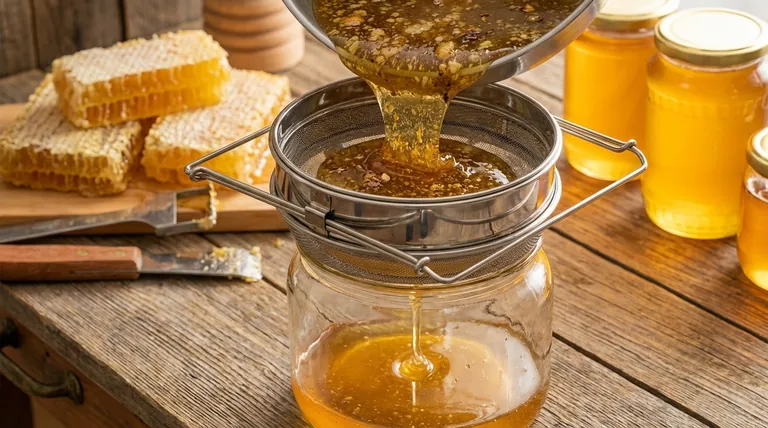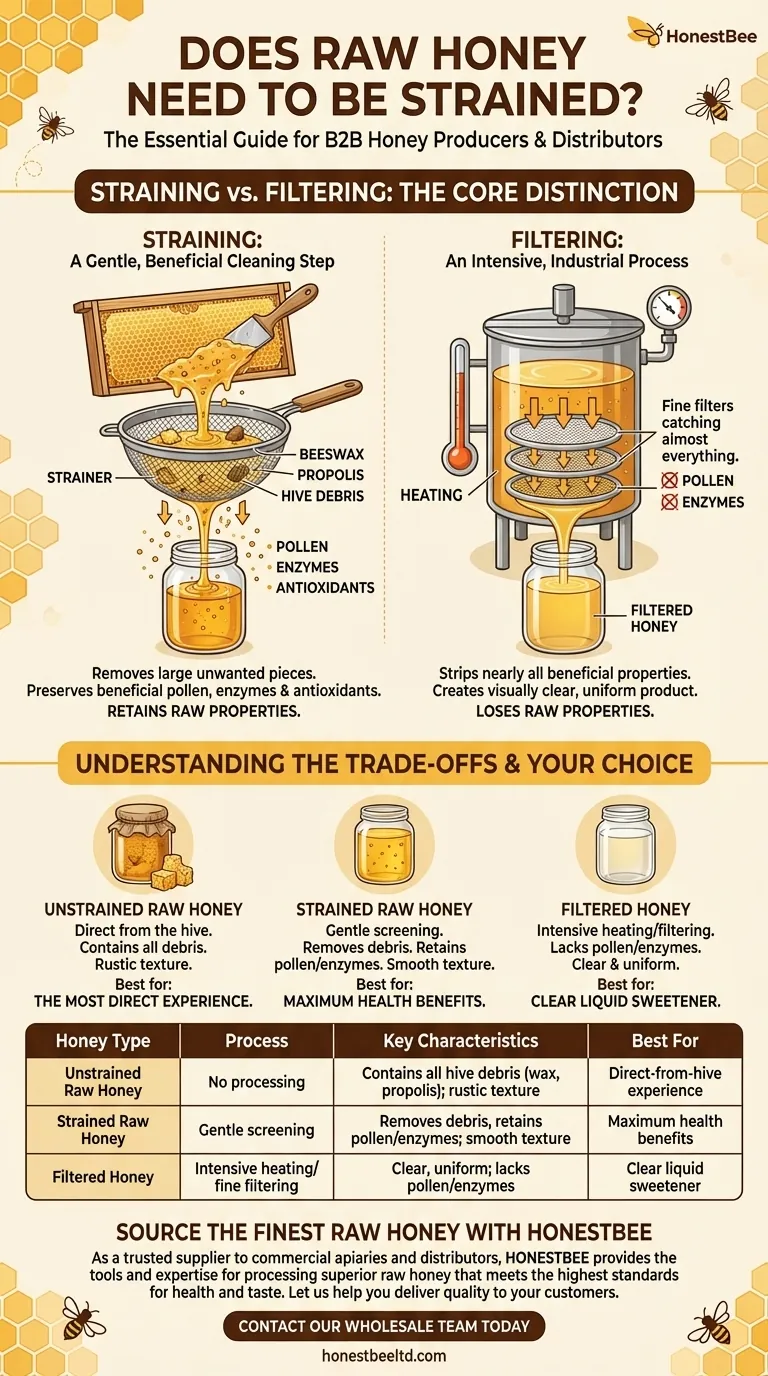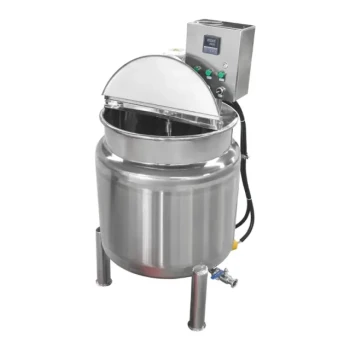While not strictly necessary, most raw honey is strained to improve its texture and remove natural debris. Because it comes directly from the honeycomb, raw honey can contain bits of beeswax, propolis, and even leftover bee parts. A gentle straining process removes these larger, unwanted pieces while preserving the beneficial pollen and enzymes that define raw honey.
The core issue isn't whether raw honey is strained, but whether it is strained versus filtered. Straining is a beneficial cleaning step, while intensive filtering can strip honey of its valuable properties.

What "Straining" Actually Means for Honey
Straining is a minimalist approach to cleaning honey. It’s a physical process designed to separate the liquid honey from solid materials left over from the hive.
The Goal: Removing Debris
The primary purpose of straining is to remove visible particles you wouldn't want to eat. This includes chunks of wax from the honeycomb, bits of propolis (a resin-like material bees create), and other hive debris.
What Straining Leaves Behind
Crucially, proper straining uses a mesh that is large enough to let important microscopic elements pass through. This ensures the honey retains its pollen, enzymes, and antioxidants, which are the components responsible for many of raw honey's health benefits.
Straining vs. Filtering: A Critical Distinction
Understanding the difference between these two processes is key to choosing the right honey. They are often confused but have vastly different impacts on the final product.
The Straining Process
Straining is a gentle, low-tech process. Beekeepers or processors simply pass the honey through a screen or mesh filter to catch the large solids. The honey remains fundamentally unchanged.
The Filtering Process
Filtering is a more intensive, industrial process. It often involves heating the honey to make it less viscous and then forcing it through very fine filters under high pressure. This creates a visually clear, uniform product that is slow to crystallize.
However, this process removes nearly everything that makes raw honey unique, including the vast majority of beneficial pollen grains.
Understanding the Trade-offs
Each type of honey offers a different balance of purity, naturalness, and convenience.
Unstrained Raw Honey
This is honey in its most direct form, scraped from the comb and bottled. While it contains the full spectrum of hive components, its texture can be unappealing to some due to the presence of wax and other particles.
Strained Raw Honey
This is the ideal for most consumers. It provides a clean, smooth product without sacrificing the valuable pollen and enzymes. You get all the benefits of raw honey without the debris.
Filtered Honey
This honey prioritizes appearance and shelf stability over nutritional value. It is perfectly clear and liquid but lacks the pollen and other micronutrients found in raw honey. Many large commercial brands sell filtered honey.
How to Apply This to Your Choice
Your decision should be based on your primary goal for consuming honey.
- If your primary focus is maximum health benefits: Choose a product clearly labeled as "raw" and "unfiltered" or "strained."
- If your primary focus is the most direct-from-the-hive experience: Seek out unstrained raw honey from a local beekeeper, but be prepared for a rustic texture.
- If your primary focus is a clear, liquid sweetener for tea or baking: Filtered honey will work, but recognize that you are missing the unique benefits of raw honey.
Ultimately, understanding the label is your most powerful tool for choosing a honey that aligns with your wellness goals.
Summary Table:
| Honey Type | Process | Key Characteristics | Best For |
|---|---|---|---|
| Unstrained Raw Honey | No processing | Contains all hive debris (wax, propolis); rustic texture | Direct-from-hive experience |
| Strained Raw Honey | Gentle screening | Removes debris, retains pollen/enzymes; smooth texture | Maximum health benefits |
| Filtered Honey | Intensive heating/fine filtering | Clear, uniform; lacks pollen/enzymes | Clear liquid sweetener |
Source the Finest Raw Honey with HONESTBEE
As a trusted supplier of beekeeping supplies and equipment to commercial apiaries and distributors, HONESTBEE understands the critical balance between purity and quality. Whether you're a large-scale producer or a distributor, we provide the tools and expertise to help you process honey that meets the highest standards for health and taste.
Let us help you deliver superior raw honey products to your customers.
Contact our wholesale team today to discuss your apiary's needs.
Visual Guide

Related Products
- Stainless Steel Double Layer Honey Strainer Sieve Filters
- Conical Nylon Honey Strainer Filter Bag for Beekeeping and Honey Filtration
- Honey Concentrating and Filtering Dehumidifier Machine 2T Capacity for Honey
- 10L Stainless Steel Electric Honey Press Machine
- Electric Honey Press Machine for Squeezing Honey Comb Press Equipment
People Also Ask
- What is a honey strainer used for? Clean, Clear Honey for Hobbyists & Small-Scale Beekeepers
- What is a steel strainer used for? A Kitchen Essential for Precision & Hygiene
- What is the best material for straining honey? Achieve Pure, High-Quality Honey with the Right Materials
- What is the purpose of honey strainers in beekeeping? Ensure Clean, High-Quality Honey
- What makes polyurethane foam environmentally friendly? The Surprising Benefits of a Durable, Inert Material



















